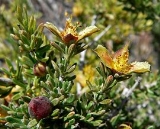
Coleogyne
Encyclopedia
Coleogyne is a monotypic genus in the rose family
containing the single species Coleogyne ramosissima, which is known by the common name blackbrush. This thorny, aromatic shrub
is native to the desert
s of the southwestern United States
. It is a thickly branched thicket which may spread across the ground in clumps or grow erect to approach two meters in height. It is drought-deciduous, such that its branches are covered in clumps of fuzzy thick leaves until the hottest, driest parts of the desert year when it drops some of its foliage and becomes dormant for the season.
This plant forms vast monotypic stands across the desert floor and on scrubby slopes. Flowering is triggered by a heavy spring rain in this desert-adapted species. The leathery flowers grow at the ends of small stems. They are encased in thick, fuzzy sepal
s which are yellow inside and reddish or orange on the outer surface. There are no petals, but the sepals remain after the flower opens, surrounding the patch of whiskery stamen
s and the central pistil
. The fruit is an achene
a few millimeters long. The plant reproduces from seed, but very rarely. The seeds do not disperse well and seedlings do not survive in large numbers. A narrow range of temperature and moisture is required for the reproduction of this species, so it is sporadic, but the plants are hardy and long-lived.
C. ramosissima produces stenophyllanin A
, a polyphenol.
Rosaceae
Rosaceae are a medium-sized family of flowering plants, including about 2830 species in 95 genera. The name is derived from the type genus Rosa. Among the largest genera are Alchemilla , Sorbus , Crataegus , Cotoneaster , and Rubus...
containing the single species Coleogyne ramosissima, which is known by the common name blackbrush. This thorny, aromatic shrub
Shrub
A shrub or bush is distinguished from a tree by its multiple stems and shorter height, usually under 5–6 m tall. A large number of plants may become either shrubs or trees, depending on the growing conditions they experience...
is native to the desert
Desert
A desert is a landscape or region that receives an extremely low amount of precipitation, less than enough to support growth of most plants. Most deserts have an average annual precipitation of less than...
s of the southwestern United States
Southwestern United States
The Southwestern United States is a region defined in different ways by different sources. Broad definitions include nearly a quarter of the United States, including Arizona, California, Colorado, Nevada, New Mexico, Oklahoma, Texas and Utah...
. It is a thickly branched thicket which may spread across the ground in clumps or grow erect to approach two meters in height. It is drought-deciduous, such that its branches are covered in clumps of fuzzy thick leaves until the hottest, driest parts of the desert year when it drops some of its foliage and becomes dormant for the season.
This plant forms vast monotypic stands across the desert floor and on scrubby slopes. Flowering is triggered by a heavy spring rain in this desert-adapted species. The leathery flowers grow at the ends of small stems. They are encased in thick, fuzzy sepal
Sepal
A sepal is a part of the flower of angiosperms . Collectively the sepals form the calyx, which is the outermost whorl of parts that form a flower. Usually green, sepals have the typical function of protecting the petals when the flower is in bud...
s which are yellow inside and reddish or orange on the outer surface. There are no petals, but the sepals remain after the flower opens, surrounding the patch of whiskery stamen
Stamen
The stamen is the pollen producing reproductive organ of a flower...
s and the central pistil
Gynoecium
Gynoecium is most commonly used as a collective term for all carpels in a flower. A carpel is the ovule and seed producing reproductive organ in flowering plants. Carpels are derived from ovule-bearing leaves which evolved to form a closed structure containing the ovules...
. The fruit is an achene
Achene
An achene is a type of simple dry fruit produced by many species of flowering plants. Achenes are monocarpellate and indehiscent...
a few millimeters long. The plant reproduces from seed, but very rarely. The seeds do not disperse well and seedlings do not survive in large numbers. A narrow range of temperature and moisture is required for the reproduction of this species, so it is sporadic, but the plants are hardy and long-lived.
C. ramosissima produces stenophyllanin A
Stenophyllanin A
Stenophyllanin A is a tannin. It can be found in Cowania mexicana, Coleogyne ramosissima and Quercus stenophylla....
, a polyphenol.

